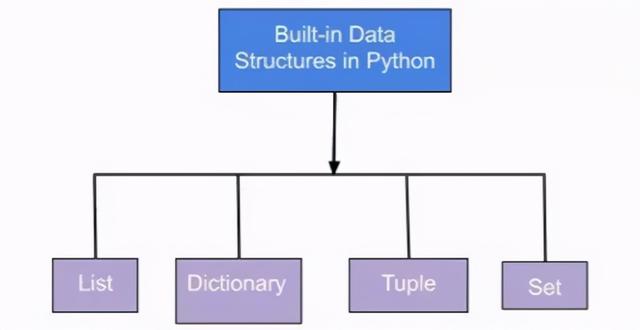万能Python的秘诀:操纵数据的内置工具
全文共6949字 , 预计学习时长18分钟 文章插图
文章插图
图源:unsplash
Python可谓是如今最流行的编程语言 , 甚至孩子们也可以从它开始学习趣味编程 。 Python类似英语的简单语法使它成为一种通用语言 , 已在全世界各个领域被广泛使用 。
Python的万能之处正在于其内置的数据结构 , 它使编码变得简单 , 不受数据类型限制 , 并可以根据需要操纵数据 。
首先 , 让我们试着理解什么是数据结构?数据结构是能够存储、组织和管理数据的结构/容器 , 以便能够有效地访问和使用数据 。 数据结构就是收集数据类型 。 Python中有四种内置数据结构 。 它们是:
· 列表
· 字典
· 元组
· 集合 文章插图
文章插图
开发人员最常用的数据结构是列表和字典 。 接下来 , 让我们详细看看每一个数据结构 。 文章插图
文章插图
列表Python列表是按顺序排列的任意类型的项的集合 。 一个列表可以有重复的项 , 因为每个项都是使用索引访问的 , 而且可以通过使用负索引逆向访问该列项 。 列表是可变的 , 这意味着即使在创建了项之后 , 也可以添加、删除或更改项;一个列表中还可以包含另一个列表 。 文章插图
文章插图
图源:unsplash
创建列表:列表可以通过将元素括在[ ]方括号中来创建 , 每个项之间用逗号分隔 。 以购物清单为例 , 创建列表的语法是:
#Creating a list fruits = ['Apple', 'Banana', "Orange"]print(type(fruits)) #returns typeprint(fruits) #prints the elements of the listOutput:访问列表:可以使用索引访问列表中的项 。 列表中的每个项都有一个与之关联的索引 , 具体取决于该项在列表中的位置 。 访问列表中的项的语法:
#Access elements in the fruits listfruits = ['Apple', 'Banana',"Orange"]print(fruits[0]) #index 0 is the first elementprint(fruits[1])print(fruits[2])Output:AppleBananaOrange但是 , 索引不必总是为正 。 如果想逆向访问列表 , 也就是按照相反的顺序 , 可以使用负索引 , 如下所示:
【万能Python的秘诀:操纵数据的内置工具】#Access elements in the fruits list using negative indexesfruits = ['Apple','Banana', "Orange"]print(fruits[-1]) #index -1 is the last elementprint(fruits[-2])print(fruits[-3])Output:OrangeBananaApple如果必须返回列表中两个位置之间的元素 , 则使用切片 。 必须指定起始索引和结束索引来从列表中获取元素的范围 。 语法是List_name[起始:结束:步长] 。 在这里 , 步长是增量值 , 默认为1 。
#Accessing range of elements using slicingfruits = ['Apple', 'Banana',"Orange"]fruits #all elements ['Apple', 'Guava', 'Banana', 'Kiwi'] #outputfruits[::1] #start to end with step 1['Apple', 'Guava', 'Banana', 'Kiwi'] #outputfruits[::2] #start to endwith step 2 basically index 0 & 2['Apple', 'Banana'] #outputfruits[::3] #start to end with step 2 basically index 0 & 3['Apple', 'Kiwi'] #outputfruits[::-1] #start to end with step 2 - reverse order['Kiwi', 'Banana', 'Guava', 'Apple'] #output向列表中添加元素:可以使用append()、extend()和insert()函数向列表添加项 。
#Adding elementsfruits = ['Apple', 'Banana', "Orange"]#Appendnew elementsfruits.append('Kiwi')print(fruits)Output:['Apple', 'Banana', 'Orange', 'Kiwi']#Insertelements in to the listfruits.insert(1,'Guava') #inserts Guava as secondelement is the list since the index is specified as 1print(fruits)Output:['Apple', 'Guava', 'Banana','Orange', 'Kiwi'] 从列表中删除项:与添加元素类似 , 从列表中删除元素也非常容易 , 可以使用del()、remove()和pop()方法实现 。 要清除整个列表 , 可以使用clear()函数 。
· del()函数删除给定索引处的元素 。
· pop()函数从列表中删除给定索引处的元素 , 也可以将删除的元素赋值给变量 。 如果未指定索引值 , 则删除列表中的最后一个元素 。
· remove()函数根据元素的值来删除元素 。
· clear()函数清空列表 。
#Deleting elements from the listfruits = ['Apple', 'Guava', 'Banana','Orange', 'Kiwi']#del() functiondel fruits[3] #delete element at index 4print(fruits)Output:['Apple', 'Guava', 'Banana', 'Kiwi']#pop()functiondel_fruit = fruits.pop(2)print(del_fruit)print(fruits)Output:'Banana'['Apple', 'Guava', 'Orange', 'Kiwi']#Remove functionfruits.remove('Apple')print(fruits)Output:['Guava', 'Banana', 'Orange', 'Kiwi']#Clear() functionfruits.clear()print(fruits)Output :[] # clears the list
- 智能手机市场|华为再拿第一!27%的份额领跑全行业,苹果8%排在第四名!
- 会员|美容院使用会员管理软件给顾客更好的消费体验!
- 行业|现在行业内客服托管费用是怎么算的
- 人民币|天猫国际新增“服务大类”,知舟集团提醒入驻这些类目的要注意
- 国外|坐拥77件专利,打破国外的垄断,造出中国最先进的家电芯片
- 技术|做“视频”绿厂是专业的,这项技术获人民日报评论点赞
- 面临|“熟悉的陌生人”不该被边缘化
- 中国|浅谈5G移动通信技术的前世和今生
- 页面|如何简单、快速制作流程图?上班族的画图技巧get
- 桌面|日常使用的软件及网站分享 篇一:几个动态壁纸软件和静态壁纸网站:助你美化你的桌面
